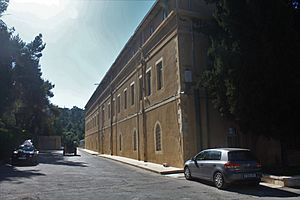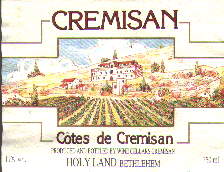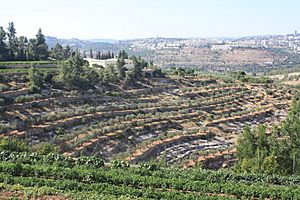Cremisan Valley facts for kids
The Cremisan Valley is a beautiful green area located where the West Bank and Jerusalem meet. It's one of the last big green spaces in the Bethlehem area. You can find farms, places to relax, and important religious buildings here. These include the Salesian Sisters Convent and School, the Salesian Monastery, and the Cremisan Cellars.
Contents
Salesian Sisters Convent and School
The Salesian Sisters Convent and School is part of the Salesian religious order. This order was started by a person known as Don Bosco. The school and convent opened in 1960. Today, about 400 students attend the primary school and kindergarten. There's also a special school for children with learning disabilities. In the afternoons and during summer, the school also hosts many fun community activities.
Cremisan Monastery
The Cremisan Monastery sits on a hill about 850 meters (2,789 feet) above sea level. It's about five kilometers (3 miles) from Bethlehem. The monastery was built in 1885. It stands on the ruins of an even older monastery from the 7th century, built by the Byzantines. The main monastery building has stone floors, thick walls, and high arched ceilings. You can see pictures of Pope John Paul II and Don Bosco decorating the inside.
The monastery is officially within Jerusalem's city limits. However, its storeroom, just across the parking lot, is in the West Bank. The road leading to the monastery passes an office that helps coordinate between Israel and the Palestinian Authority.
Cremisan Cellars
Cremisan Cellars is a winery that has been making wine since the monastery was first built in the 1800s. They added modern equipment in 1977 to help with winemaking. Most of the grapes they use come from the al-Khader area. Only a small amount (about 2%) of the 700,000 liters of wine they make each year comes from Cremisan's own grapes. The rest of the grapes come mainly from nearby places like Beit Jala, Beit Shemesh, and the Hebron area.
Land and the Separation Barrier
For many years, there has been a discussion about a separation barrier in the Cremisan Valley. This barrier is a wall or fence built for security reasons. In 2006, Israeli military authorities planned a route for this barrier. This plan would have taken over some private farmland and land belonging to the Catholic Church. It would also have separated the two Salesian monasteries in the valley. The 19th-century monastery would have been on the Jerusalem side, while the nearby convent and school would have been on the Palestinian side.
In 2013, a special court committee approved taking land for the barrier. This route would have included about 75% of the convent's land. It would have surrounded the convent on three sides. The wall would also have taken farmland from 58 Palestinian families. Israeli military authorities said the wall was needed for safety. They explained it was to stop possible attacks from people entering Israeli towns and settlements.
Later plans for the barrier in 2012 showed it going around the convent, keeping it on the Palestinian side. But it would still split the convent from the monastery. This meant elementary school children would still be able to attend the school. They would pass soldiers at an Israeli checkpoint. Landowners would have limited access to their farms through a special agricultural gate.
Some human rights groups, like B'Tselem, pointed out that most of the barrier's route was inside the West Bank. It did not follow the original Green Line. People living in Beit Jala believed the route was chosen to connect the Israeli settlement of Har Gilo in the West Bank to nearby Gilo.
Church leaders also spoke about the situation. In 2013, Bishop Richard Pates wrote a letter to U.S. Secretary of State John Kerry. He said that what was happening in the Cremisan Valley showed a bigger problem. He explained that if the wall moved and restricted more communities, it would make it harder to find a peaceful solution for the future. He believed that separating families from their land could cause more frustration.
During a period of conflict around 2000, there were security concerns in the area. An Israeli Defence Ministry spokesman, Joshua Hantman, said the barrier's route was based on specific security needs. He stated it was there only to keep danger out of Jerusalem. Palestinians, however, saw the project as a way to gain more land in the West Bank.
The legal fight over the land lasted for nine years. The two local monasteries and the 58 Palestinian landowners in Beit Jala went to court. In April 2015, the Israeli Supreme Court made a decision. It ruled that the monastery and convent should stay connected on the Palestinian side of the separation barrier. This was an important decision. It was the second time the Supreme Court decided to keep an area in the West Bank together. The first time was for the villagers of Battir, who also fought to stop the wall from dividing their traditional lands.
See also
 In Spanish: Monasterio de Cremiso para niños
In Spanish: Monasterio de Cremiso para niños




